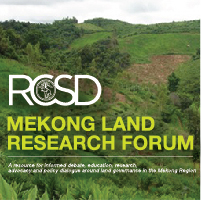Location
The purpose of the Mekong Land Research Forum online site is to provide structured access to published and unpublished research on land issues in the Mekong Region. It is based on the premise that debates and decisions around land governance can be enhanced by drawing on the considerable volume of research, documented experience and action-based reflection that is available. The online site seeks to organise the combined work of many researchers, practitioners and policy advocates around key themes relevant to the land security, and hence well-being, of smallholders in Cambodia, Laos, Myanmar, Thailand and Vietnam.
The research material on this site is mounted at three levels:
First, a selection of journal articles, reports and other materials is provided and organised thematically to assist researchers, practitioners and policy advocates to draw on one another’s work and hence build up a collective body of knowledge. This is the most “passive” presentation of the research material; our contribution is to find and select the most relevant material and to organise it into key themes. In some cases the entire article is available. In others, for copyright reasons, only an abstract or summary is available and users will need to access documents through the relevant journal or organisation.
Second, a sub-set of the articles has been annotated, with overall commentary on the significance of the article and the research on which it is based, plus commentary relevant to each of the key themes addressed by the article.
Third, the findings and key messages of the annotated articles are synthesised into summaries of each of fourteen key themes. For each key theme, there is a one-page overall summary. Extended summaries are being developed progressively for each theme as part of the Forum's ongoing activity.
Overall, we intend that this online site will contribute toward evidence-based progressive policy reform in the key area of land governance. We further hope that it will thereby contribute toward to the well-being of the rural poor, ethnic minorities and women in particular, who face disadvantage in making a living as a result of insecure land tenure.
Members:
Resources
Displaying 431 - 435 of 564National Gender Profile of Agricultural Households 2010
Cambodia has a land area of 181 035 square kilometers and a population of almost 14 million people (2008). In 2008, about 82 percent of the households lived in rural areas. A large majority of these households engage in rice- based agriculture, collection of forest products and livestock production. The agricultural sector generates about 32 percent of the Gross Domestic Product and provides employment to about 80 percent of the country’s labour force. The sector is dominated by small farm households who are mainly engaged in subsistence production.
Rural women's access to land and property in selected countries: Progress towards achieving the aims of the Convention on the Elimination of all forms of Discrimination against Women (CEDAW) INCLUDING 2010 UPDATE
In 2010, the ILC Secretariat decided to update information contained in the 2004 publication, so as to have a new basis to work more closely with and through CEDAW at national level. The update gives more visibility to the CEDAW Committee’s Concluding Observations and, accordingly, also to the CSOs’ shadow reports feeding them. This inclusion offers a more critical and comprehensive, if preliminary, overview of the situation of rural women in selected countries. NOTE: The 2004 publication is also available through this site.
Tyrants, Tycoons and Tigers
ABSTRACTED FROM SUMMARY: A bitter land struggle is unfolding in northern Burma’s remote Hugawng Valley. Farmers that have been living for generations in the valley are defying one of the country’s most powerful tycoons as his company establishes massive mono-crop plantations in what happens to be the world’s largest tiger reserve. The Hukawng Valley Tiger Reserve in Kachin State was declared by the Myanmar Government in 2001 with the support of the US-based Wildlife Conservation Society.
Climate Change, Water and Agriculture in the Greater Mekong Subregion
The impacts of climate change on agriculture and food production in Southeast Asia will be largely mediated through water, but climate is only one driver of change. Water resources in the region will be shaped by a complex mixture of social, economic and environmental factors.
Forestry policies, legislation and institutions in Asia and the Pacific: Trends and emerging needs for 2020
Over the past decade the Asia-Pacific region has experienced tremendous changes in nearly every aspect. These changes have been particularly profound in the forestry sector, where society has dramatically increased its demands and expanded its expectations for goods and services. Almost all countries in the region have moved towards sustainable forest management at the policy level and in many countries institutional structures are also gradually changing.


